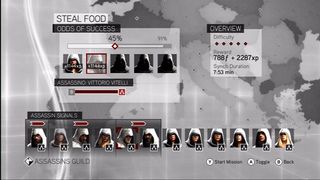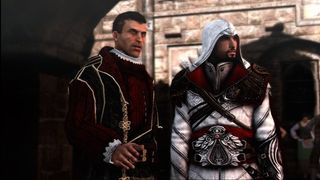Why you can trust GamesRadar+
You could, for example, ignore five of the six Romulus Lairs (Brotherhood’s answer to ACII’s Assassin Tombs) – but then you’d miss out on some expertly designed levels that range from huge, empty environmental puzzles to fight-heavy dungeons filled with creepy guys in wolf headdresses. (You also wouldn’t get access to the best armor in the game.)

Likewise, you could completely pass on the opportunity to help Ezio’s old friend Leonardo da Vinci, who needs you to destroy the war machines he’s been forced to create for the Borgia. But, again, you’d miss out on cool missions that climax with you being able to pilot the inventions, which range from a cart-mounted machinegun and a bomb-equipped flying machine to the goddamn tank we pictured earlier. While they’re a complete departure from the rest of the game, these missions nonetheless make for a cool change of pace – and, unlike the flying-machine missions in ACII, you can replay these whenever you feel like it.

One of the cool things about Brotherhood is that, whether a mission is part of the central storyline or an optional quest, you can replay it once it’s complete – and there’s even an incentive to do so. Aside from your main objective, most missions now carry a secondary one for “full synchronization,” usually something like finishing the mission without being detected, or in a certain amount of time, or killing your target in a certain way. Again, these aren’t necessary to finish the game, but having a secondary goal to shoot for is fun.
Secondary mission goals are far from the only improvements Brotherhood brings to the AC formula. The fights have been retooled with a few new moves (and new enemies) as well, with Ezio now able to groin-kick strong opponents to lower their guards, and enemies able to grab and hold Ezio while their buddies beat up on him (which you can wriggle out of with a quick throw). You can also now attack from horseback, which feels really imprecise. But that stuff’s insignificant next to the chainable executions.

If Ezio successfully kills an enemy – most likely through a well-timed reversal – you can then switch his attention immediately to another nearby enemy with a flick of the analog stick, and instantly run them through, no matter how tough or well-armored they might be. These insta-murders can continue in an unbroken streak until your enemies land a successful attack, at which point combat resumes its normal pace. Streaks can be extremely tricky to master, but immensely satisfying to pull off; luckily, if you want to practice them (or just about anything else), there’s a Metal Gear-inspired VR training mode you can access at any time.

Above: Finish every VR mission, and you get a Raiden costume! (No, really)
Interestingly, once you’re at a certain point in the game, even fighting becomes largely optional. About halfway through the story, you’ll earn the ability to recruit followers by helping out citizens the guards are harassing. These recruits can then be trained to become Assassins, starting out as weak apprentices and gradually earning experience until they’ve become near-invincible fighters.
Weak or strong, you can call on up to six of them at virtually any time to swarm your enemies like a pack of hidden-blade-carrying wolves, or to just take out every onscreen baddie at once with a literal hail of arrows. These are particularly useful not just when you want to get out of a jam in a hurry, but also when a mission’s secondary objectives forbid you from killing anyone but your target. After all, it’s not like it’s you doing the killing, right?

Building up your troops is a separate minigame unto itself, seemingly inspired by Metal Gear Solid: Peace Walker’s Outer Ops mode. To earn experience for your recruits, you’ll need to send them on timed missions, selecting from a European map’s worth of tasks and assigning up to five recruits, depending on the mission’s difficulty.

All you need to do then is put up with not having access to some of your recruits until they get back, at which point they’ll have gained experience, money, and possibly some trade goods for you to sell to shopkeepers. It’s weirdly gratifying, especially when it eventually leads to cutscenes of your recruits’ Assassin initiation ceremonies.
While all that stuff amounts to an enormously fun, involving game, Brotherhood does have one big, glaring flaw: its story. It gets off to an especially strong start, but If you’re looking forward to an awesome narrative on the level of ACII’s, you might be disappointed. There are two big problems at work here, and the first is Ezio himself.

Above: It’s the secondary characters, like Machiavelli, that really take center stage this time
See, part of the reason ACII was so successful was that our view of the game world developed alongside Ezio’s; through his eyes, we saw Florence as a bright playground, Monteriggioni as a dreary ruin (and, later, home) and Venice as an almost intimidatingly bustling city. We also got to see him develop from a cocky, impulsive young charmer into a more mature Assassin, something that really helped us connect with him as a character.
Here, all we’ve got to connect with is the mature Assassin, who comes off much more confident and in control than he was in ACII – and is therefore less interesting.

Above: You will, however, get to see more of young Ezio in the flashback Cristina missions, which reveal more about his ill-fated, mostly offscreen romance in ACII
The other problem is that Rodrigo Borgia (aka Pope Alexander VI), who was built up so effectively as a villain in ACII, barely even appears this time around. For that matter, the control-obsessed Templars don’t even play a very significant role. Instead, Brotherhood focuses on the violent grudge between Ezio and Cesare, who – while a megalomaniacal prick – doesn’t really do too many horrible things onscreen, apart from tearing up Monteriggioni. We’re mostly told how awful he is, which doesn’t do nearly as much to build up a serious hate-on as, say, watching someone murder the hero’s family and friends right in front of him.
(Which Cesare does, to be fair, but only once.)
More info
| Genre | Action |
| Description | A spinoff sequel to Assassin's Creed II that will star Ezio as he leads the order of Assassins to conquer Rome. |
| Franchise name | Assassin's Creed |
| Platform | "PC","Xbox 360","PS3" |
| US censor rating | "Mature","Mature","Mature" |
| UK censor rating | "18+","18+","18+" |
| Alternative names | "AC Brotherhood","" |
| Release date | 1 January 1970 (US), 1 January 1970 (UK) |
136,000 Call of Duty accounts have gotten banned since ranked launched for Black Ops 6: "We’re not slowing down in our mission to shut down cheaters"
Please enjoy Super Smash Bros. boss Masahiro Sakurai's reaction to the Nintendo Switch 2 reveal: "Oooh!"

Friends star David Schwimmer finds it "really moving" how the show is still helping fans 30 years on: "I just feel really grateful"
Most Popular

